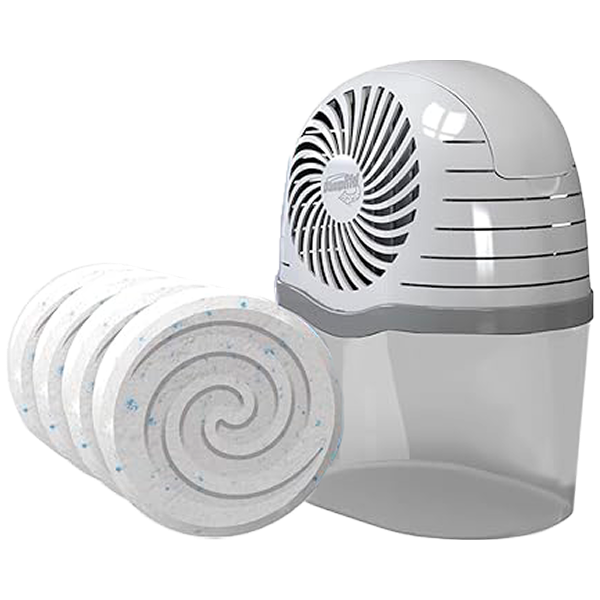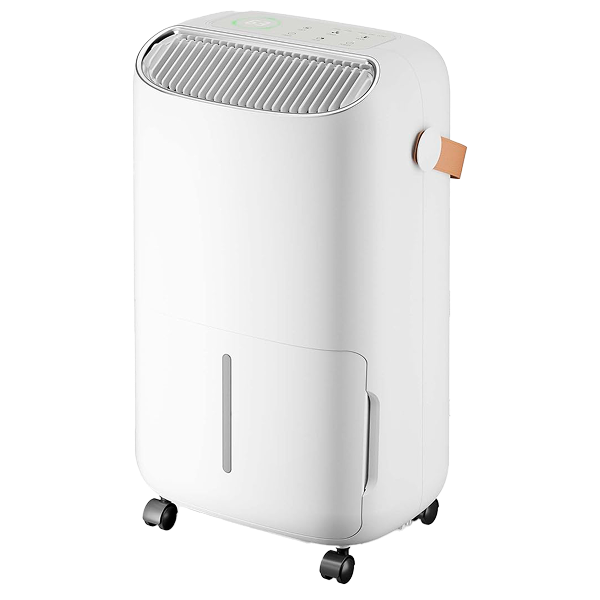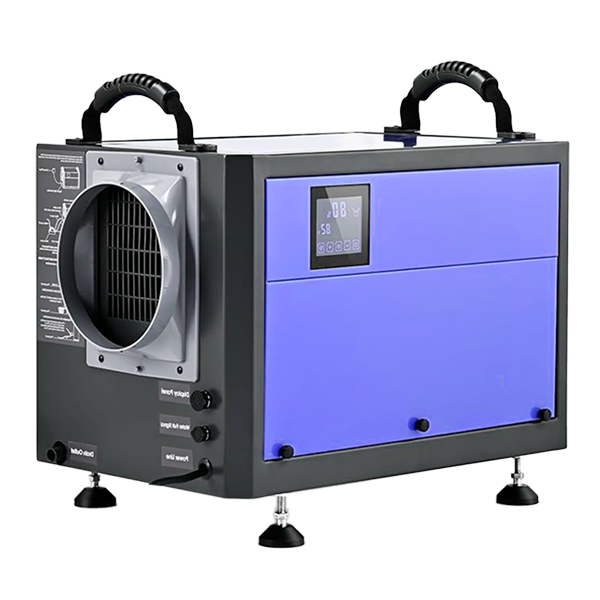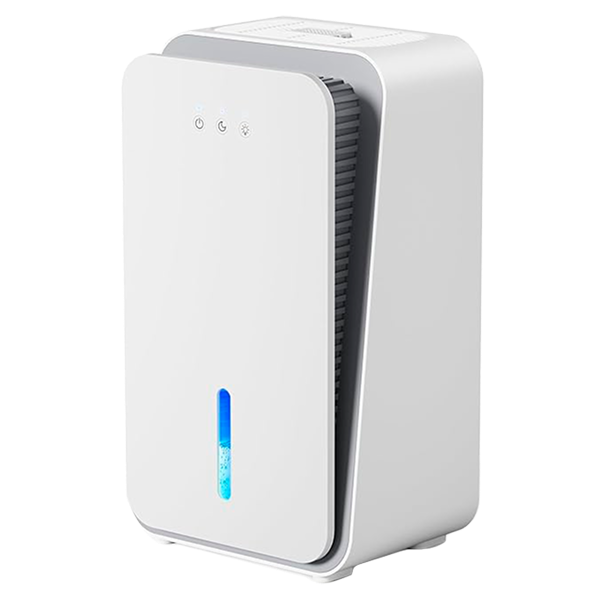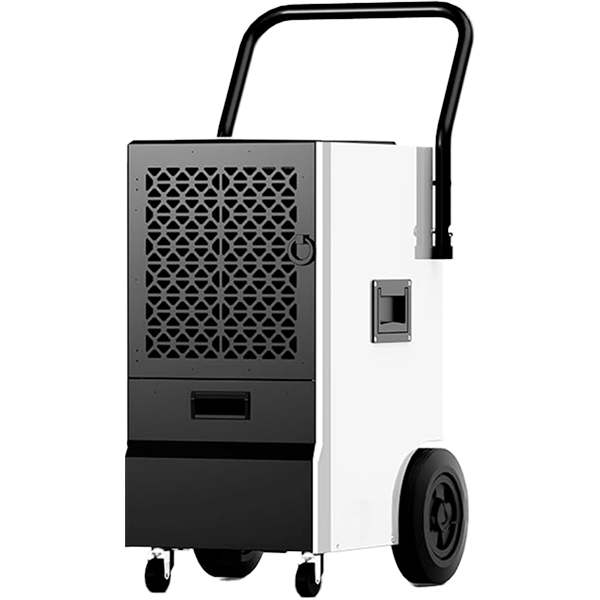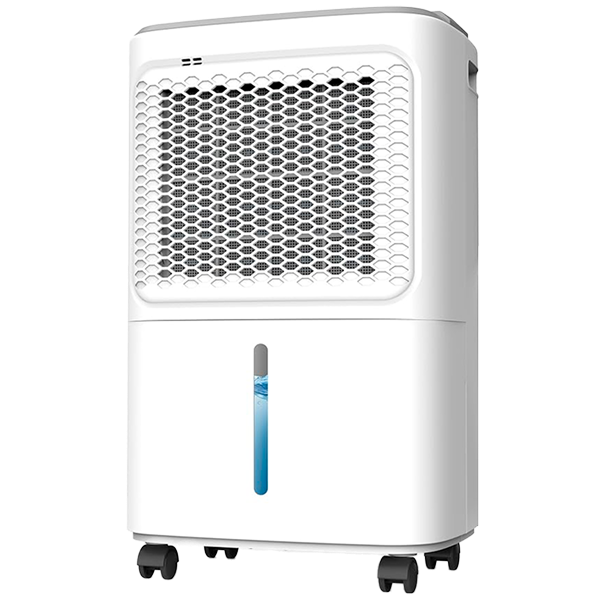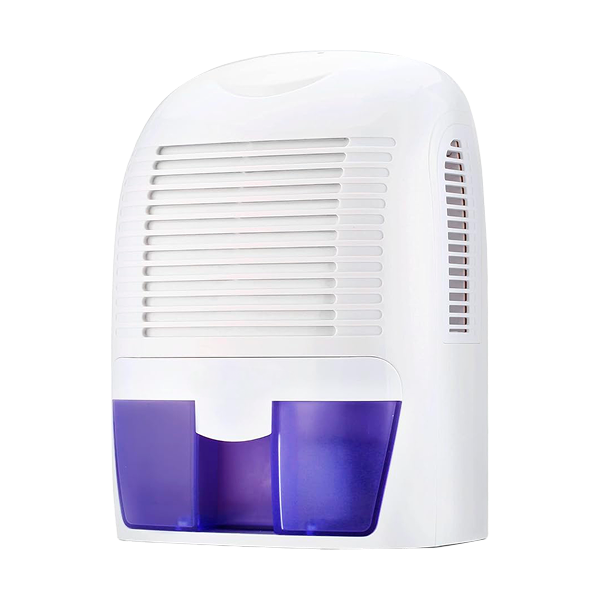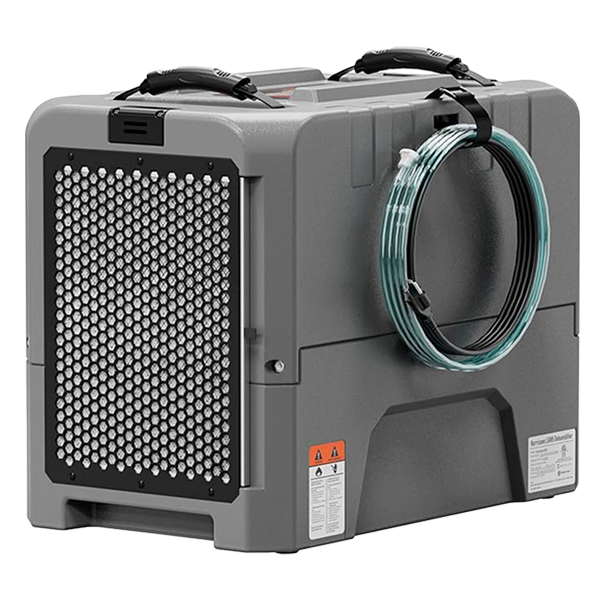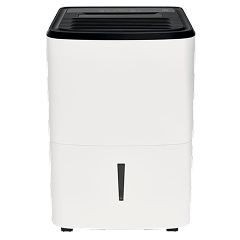Un deshumidificador portátil es aquel que se puede transportar fácilmente de una habitación a otra, o incluso entre espacios como la oficina y el hogar. Ya sea por sus ruedas, asas y mangos prácticos o por su tamaño compacto y peso ligero, es ideal para quienes necesitan combatir la humedad en diversos lugares.
Puedes llevar un deshumidificador portátil a tu casa de vacaciones, cabaña o incluso de aventura en autocaravana. En esta guía, te explicaremos qué debes buscar para que puedas elegir el deshumidificador portátil que mejor se adapte a tus necesidades.
Para obtener una descripción más amplia de los tipos de deshumidificadores, las situaciones domésticas más comunes y las marcas líderes, consulta nuestra guía general de compra de deshumidificadores.
Extracción de humedad (L/24 h)
Esto indica la cantidad de humedad que tu deshumidificador puede eliminar del aire en 24 horas. Los modelos portátiles varían en capacidad de extracción, desde 500 ml hasta 20 litros al día. Si bien la capacidad es importante, recuerda que cuanto mayor sea el tanque, mayor será el tamaño del aparato. Elige con cuidado según el uso que le vayas a dar y el espacio disponible.
- <5 L/día: incluye modelos básicos y ultracompactos. Ideal para uso a corto plazo en habitaciones pequeñas, caravanas o con problemas leves de humedad.
- 5–10 L/día: una opción versátil para dormitorios, salones y apartamentos. Estas unidades suelen ser eficientes y fáciles de transportar.
- Más de 10 L/día: ideal para humedad alta, habitaciones grandes y menor necesidad de transporte entre espacios. Ofrece un potente rendimiento de secado, ideal para secar ropa o para fugas de agua.
Si tu espacio sufre de condensación u olores a humedad, opta por un modelo de mayor extracción.
Área de cobertura (m²)
El tamaño del espacio que tu deshumidificador puede gestionar es tan importante como la capacidad. Las unidades portátiles varían considerablemente, así que elige la que mejor se adapte a tus necesidades:
- Hasta 15 m²: vestidores, baños en suite y dormitorios pequeños.
- 15–25 m²: dormitorios estándar, cocinas pequeñas o salas de estar compactas.
- 25–35 m²: estudios, habitaciones más grandes o espacios diáfanos.
- 35–45 m²: salones, sótanos, áreas de servicio o varias habitaciones comunicadas.
Si planeas trasladar el deshumidificador, ten siempre en cuenta la habitación más grande en la que podrías usarlo. Para casas de planta abierta, es mejor elegir un tamaño mayor.
Capacidad del tanque (L)
Esto determina la cantidad de humedad que puede retener la unidad antes de tener que vaciarla. Los tanques más grandes implican menos viajes al fregadero, pero también un tamaño más voluminoso.
- <2 L: requiere vaciado diario si se usa con regularidad. Ideal para espacios con baja humedad o para secado ocasional.
- 2–4 L: tamaño equilibrado para mayor portabilidad y comodidad. Ideal para habitaciones medianas.
- >4L: ideal para uso prolongado y continuo o con altos niveles de humedad. Ideal para hogares con mucha actividad.
Busca un indicador de nivel de agua, un tanque transparente o una alerta de tanque lleno para supervisar la capacidad del tanque y saber cuándo debes vaciarlo.
Características de portabilidad
La principal ventaja de los deshumidificadores portátiles es su facilidad de transporte y almacenamiento cuando no se usan. Suelen ser compactos y caben en la mayoría de las habitaciones y espacios, son fáciles de mover, cargar en un coche e incluso guardar en una maleta o caja durante una mudanza o viaje.
Ten en cuenta estos detalles al realizar tu investigación:
- Mango o empuñadura integrada: facilita el traslado de una habitación a otra.
- Diseño compacto: los modelos delgados se adaptan perfectamente a estantes o debajo de escritorios. Considera dónde planeas usar tu deshumidificador para determinar la forma y el tamaño ideales.
- Construcción liviana: ideal para transportar entre pisos o almacenar cuando no está en uso.
- Organizador de cables: permite guardar los cables de forma ordenada.
Nivel de ruido
Nadie quiere un aparato ruidoso en el dormitorio. Sin embargo, es importante recordar que todos los deshumidificadores hacen algo de ruido. Elige según el uso que le vayas a dar:
- <35 dB: prácticamente silencioso. Ideal para dormitorios y habitaciones de bebés.
- 35–45 dB: tan suave como el sonido de la lluvia, ideal para uso diurno en salas de estar o cocinas.
- 45–+50 dB: perceptible, pero no molesto. Adecuado para espacios de servicio, sótanos y espacios que se dejan sin supervisión durante el uso.
Índice de eficiencia energética (EER)
Indica la eficiencia con la que un deshumidificador convierte la electricidad en deshumidificación. Un EER más alto significa que se elimina más humedad por unidad de energía consumida. Busca las etiquetas de clase energética (A, A+, etc.) cuando corresponda. Los modelos con modos eco o motores inverter pueden reducir aún más el consumo eléctrico.
Un deshumidificador con temporizador o higrostato también reducirá el gasto de energía al funcionar solo cuando sea necesario.
Consumo de energía nominal
La mayoría de los modelos portátiles tienen una potencia de entre 150 W y 600 W, según el tamaño y la potencia de extracción. Las unidades más pequeñas (de menos de 5 L/día) consumen menos energía, pero podrían necesitar más tiempo de funcionamiento. Las unidades más grandes consumen más energía, pero terminan el trabajo más rápido.
Si te preocupan las facturas de electricidad elevadas, elige un modelo con función de apagado automático o programación inteligente. Esto te permitirá usar el deshumidificador solo cuando lo necesites.
Tipo de filtro
Algunos deshumidificadores vienen equipados con filtros que ayudan a atrapar el polvo, el pelo de las mascotas y las partículas suspendidas en el aire. Esto garantiza que el aire salga más seco y limpio. Busca:
- Filtros de polvo lavables: fáciles de quitar y enjuagar. Son comunes en unidades portátiles.
- Filtros HEPA o antibacterianos: ayudan a purificar el aire; ideales para hogares propensos a alergias.
- Acceso sin herramientas: limpiar y cambiar los filtros es más fácil y rápido.
Limpia los filtros mensualmente para mantener el rendimiento y la calidad del aire.
Rango de temperatura de funcionamiento
Los deshumidificadores portátiles funcionan mejor en ambientes cálidos, pero algunos modelos están diseñados para ser versátiles.
- Rango estándar (15–35 °C): esta es la temperatura de funcionamiento estándar de los deshumidificadores. Ideal para la mayoría de los entornos domésticos.
- Modelos preparados para el frío (<10 °C): pueden contar con descongelación automática o usar tecnología desecante. Ideales para sótanos, garajes o invernaderos sin calefacción.
Si vives en un clima más frío, evita las unidades que solo funcionan con Peltier, a menos que estén específicamente diseñadas para uso en frío.
Control de higrostato
Esta función te ayuda a establecer el nivel de humedad deseado, que la unidad mantendrá automáticamente. El control de humedad evita el secado excesivo, ahorra energía y ayuda a mantener un ambiente confortable sin que tengas que mover un dedo.
- Marcación manual: económica y fácil de usar.
- Pantalla digital: más precisa, a menudo muestra la humedad actual y permite ajustes con un solo toque.
Apagado automático (tanque lleno)
Esta es una función imprescindible en los deshumidificadores pequeños. Detiene la unidad cuando el depósito está lleno para evitar fugas y suele combinarse con un indicador de depósito lleno, generalmente una luz LED o un depósito de agua iluminado. De esta forma, siempre se te recuerda que debes vaciar el depósito de agua y se puede maximizar el uso del deshumidificador.
Conectividad inteligente/de aplicaciones + Funciones de la aplicación
Muchos modelos ahora incluyen conectividad Wi-Fi o Bluetooth. Las funciones que podrás usar a través de tu teléfono dependen del modelo y el fabricante. Estas suelen incluir:
- Control remoto: enciende y apaga la unidad de forma remota y ajusta la configuración desde tu teléfono.
- Alertas de humedad: recibe una notificación si la humedad aumenta repentinamente.
- Soporte 24 horas, los 7 días de la semana: es posible que puedas obtener atención al cliente a través de la aplicación.
Funciones adicionales
Tipo de refrigerante
Los modelos portátiles basados en refrigerantes suelen utilizar gases más seguros para el medio ambiente, como el R290 o el R134a. Si la sostenibilidad es importante, verifica el tipo de refrigerante:
- R290: refrigerante natural, de bajo PCA (Potencial de Calentamiento Global). Cada vez más utilizado en modelos modernos de bajo consumo energético.
- R134a: común, pero con mayor PCA.
Modo de lavado
Muchos deshumidificadores portátiles ahora incluyen un modo de lavado o secado, diseñado para acelerar el secado de la ropa al aire. Este modo suele aumentar la velocidad del ventilador y funciona continuamente hasta que se apaga. Es ideal para los meses de invierno o para pisos sin opciones de secado al aire libre, y ayuda a prevenir el olor a humedad.
Busca un botón, icono o modo específico en el panel de control.
Pantalla del higrostato
Los higrostatos digitales muestran la humedad ambiental actual y permiten establecer niveles objetivo. Estos:
- Proporcionan control de precisión
- Ayudan a reducir los costes de energía
- A menudo incluyen indicadores de color o pantallas retroiluminadas.
Esto es especialmente útil si controlas la humedad por razones de salud, como asma o alergias.
Opciones de color, material y ubicación del tanque
La portabilidad no implica sacrificar el estilo. Busca:
- Colores neutros: los tonos blancos, grises o negros se combinan con los hogares modernos.
- Tanques transparentes: facilitan la verificación de los niveles de agua de un vistazo.
- Acceso frontal o lateral: más fácil de quitar y reemplazar que los tanques de agua instalados en la parte trasera.
Los acabados mate o texturizados ayudan a resistir las huellas dactilares y las manchas.
Descripción general de los principales fabricantes
Meaco
Ideal para: Tecnología inteligente y silenciosa | Uso en el dormitorio
Meaco se especializa en máquinas silenciosas y eficientes que se integran a la perfección en hogares modernos. Su gama “ABC” es especialmente popular en espacios sensibles al ruido.
- Casi silencioso (tan bajo como 35 dB)
- Pantallas digitales con humedad objetivo
- Bajo consumo de energía con modos de temporizador
- Algunos modelos ofrecen drenaje continuo.
Contras: Precio más alto, pero obtienes funciones y soporte premium.
Pro Breeze
Ideal para: uso diario asequible
Pro Breeze es una de las marcas más populares de deshumidificadores compactos. Sus modelos están diseñados para hogares con humedad, con características fiables y un diseño fácil de usar.
- Comúnmente incluye tasas de extracción de 500 ml a 2 L/día.
- Diseño ligero y listo para usar
- Excelente para baños, dormitorios y caravanas
- Económico sin sacrificar las características principales
Contras: espera solo funciones básicas y carcasas de plástico, sin funciones inteligentes ni filtración avanzada.
De’Longhi
Ideal para: Diseño elegante y de alta calidad | Características de lavandería
De’Longhi, conocido por sus electrodomésticos robustos de diseño italiano, ofrece modelos de primera calidad con características bien pensadas y un aspecto elegante.
- Excelentes modos de secado de ropa
- Carcasas elegantes y duraderas con tanques de gran tamaño
- Higrostatos digitales incorporados
- Ideal para hogares con estilo que necesitan un secado potente
Contras: Precio elevado; tamaño más grande.
EcoAir
Ideal para: Fiabilidad durante todo el año | Rendimiento en ambientes fríos
EcoAir se especializa en deshumidificadores desecantes que destacan en condiciones de frío. Sus modelos son ideales para cuartos de servicio, garajes y casas de invierno.
- Funciona bien en temperaturas bajas
- Funcionamiento silencioso con filtros purificadores de aire
- Fuerte extracción incluso en espacios sin calefacción
- Muy adecuado para los inviernos del Reino Unido
Contras: Utiliza más energía que los modelos refrigerantes o Peltier.


